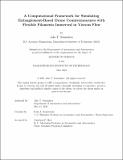A Computational Framework for Simulating Entanglement-Based Drone Countermeasures with Flexible Filaments Immersed in Viscous Flow
Author(s)
Sonandres, Jake T.
DownloadThesis PDF (5.831Mb)
Advisor
Radovitzky, Raúl A.
Terms of use
Metadata
Show full item recordAbstract
In this work, we present a computational framework for modeling the coupled dynamic interactions of highly flexible slender filaments immersed in a viscous flow and their entanglement with themselves and moving structures. This work is motivated by a novel drone countermeasure that entangles propellers with flexible filament clouds, inducing a loss of thrust and control authority in the drone. However, the framework is relevant to a wider range of applications, including actin filaments in cell biology, carbon nanotubes in composite materials, and rope-like structures in industrial settings. Each filament is modeled with the three-dimensional geometrically exact Kirchhoff-Love torsion-free finite element beam formulation. The fluid flow resulting from filament aerodynamic interaction is described through a Boundary Integral (BI) formulation of the incompressible Stokes equations based on the Stokeslet discretization. The heavy computational load of the resulting dense system is addressed through the use of fast GPU-based dense linear solvers. The BI formulation is coupled to the filament solid mechanics by enforcing momentum balance at the dynamically evolving filament-fluid interface. Additionally, the solid contact interactions between filaments are modeled with a point-to-point frictional contact algorithm that applies discrete contact and frictional forces at the closest point between the beam elements. We address the difficulties associated with contact between elements represented with third-order Hermitian polynomial shape functions and the strategies adopted to overcome these challenges. To capture propeller fouling for drone countermeasures, we incorporate a propeller and motor model whose thrust and torque responses are affected by contact interactions during entanglement. We verify our framework against simple analytical solutions and demonstrate its capabilities with numerical examples that attempt to capture large-scale filament entanglement behavior. In particular, we apply our methodology to demonstrate the process by which filament entanglement can restrict motion and reduce the efficacy of propellers. The results show that the framework can be used to understand the connection between filament entanglement, key system properties, and the resulting thrust generated by the propeller.
Date issued
2025-05Department
Massachusetts Institute of Technology. Department of Aeronautics and AstronauticsPublisher
Massachusetts Institute of Technology